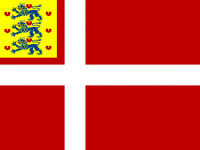Denmark

| |
| Subdivision of: | Scandinavian Realm |
| Cities: | |
| Capital: | Køpenhavn |
| Largest: | Køpenhavn |
| Other: | Århus, Odense, Ålborg, Malmø, Halmstad |
| Languages: | |
| Official: | Riksmål |
| Others: | Danish |
Denmark is part of the Scandinavian Realm and was one of the founding entities. Denmark shares a condominium
History
Ancient History
People lived in what is today Denmark more than 100,000 years ago, but they were likely forced to leave for a time because of the ice cap that covered the land for some of the intervening time during the ice age. It is thought that people have lived continually in Denmark since around 12,000 BC. Agriculture made inroads around 3,000 BC. The Nordic Bronze Age period in Denmark was marked by a culture which buried its dead, with their worldly goods, beneath burial mounds. Many dolmens and rock tombs (especially "passage graves") date from this period. Among the many bronze finds from this period are beautiful religious artifacts and musical instruments, and the earliest evidence of social classes and stratification.
Occasionally people were killed and thrown in bogs during this time. They are known as bog bodiesToday these people are uncovered very well preserved and are valuable resources of information about the people who lived in Denmark during this period.
During the Iron Age (500 BC - 1 AD), the climate in Denmark and southern Scandinavia may have become cooler and wetter, limiting agriculture and setting the stage for native groups to migrate southward into Germania. At around this time, people began to extract iron from the ore in peat bogs. Evidence of Celtic immigration and culture dates from this period in Denmark and much of northwest Europe, and is reflected in some of the older place names.
The Roman provinces, whose frontiers stopped well short of Denmark, nevertheless maintained trade routes and relations with Danish peoples, attested by finds of Roman coins. About AD 200 the first runic inscription appeared. Depletion of cultivated land in the last century BC seems to have contributed to increasing migrations in northern Europe and increasing conflict of Teutonic tribes with Roman settlements in Gaul. Roman artifacts are especially common in finds from the first century AD.
Vikings
People who became known as Vikings inhabited much of Denmark for the several hundred years from the 8th to the 11th century AD. They had a more complicated social structure than most previous societies to inhabit the areas and became famous for the raiding and trading throughout the rest of Europe.
During the Viking period, Denmark was a great power. In the early 11th century, King Knut (English: Canute) united Denmark and England for almost 30 years.
Kalmar Union
Riksfællegsskap
Geography
Borders
North: Skagerrak.
West: North Sea.
South: Schleswig-Holstein.
Southeast: Baltic Sea.
Northeast: Sweden.
| |||
|---|---|---|---|
| National States | |||
| Denmark | Sweden | Norway | Finland | Rygen | Samme | Schleswig-Holstein | Oldenburg | Lybæk | Faeroe Islands | Iceland | Greenland | New Sweden | New Iceland | Gadangmeland | Gebaland | Pepper Coast | Cruzan Islands | Tranquebar | Frederiksnagore | Nicobar Islands | Andaman Islands | Monland | Tenasserim | Tsingdav | |||
| Territories | |||
| North Atlantic Dependency | South Atlantic Dependency | Antarctic Dependency | |||
| Realm Capital Territory | |||
| Rikshovedstadsområde |
